Reviewed by Grant McCreary on February 23rd, 2010.
Any warbler is a good warbler. That was my motto when I started birding, and I find that I still feel the same way today. By that, I mean that the sighting of any warbler species, no matter how common, is enough to make my day bird-wise. (Although I must admit that I can get jaded with the hoards of Yellow-rumped Warblers pretty quickly.) If you’re like me in that even a glimpse of one of these sprites gets your heart racing, then these two Watching Warblers films may be dangerous to your health.
Warblers of the family Parulidae (also known as Wood Warblers or New World Warblers, to differentiate them from the unrelated Old World Sylviidae warblers) are small, but usually fantastically bright colored, songbirds. As a whole, they are relatively common across North America, mostly as migrants or summer breeders. You can tell that they are around if you attune yourself to their various trills, buzzes, and chirps. But seeing them is another matter. They are typically small, very active, and remain in dense vegetation or high in the treetops. Photographing them is difficult, getting video footage downright infuriating. But somehow, Michael Male and Judy Fieth have managed to do it on these two DVDs.
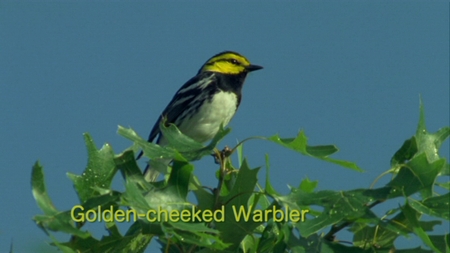
Watching Warblers
Watching Warblers profiles each of the 39 warblers from eastern North America during its 59 minute runtime. Starting in a wooded swamp of the southeast, it works its way north through the various warbler breeding habitats until it reaches the boreal forest. During each of these accounts, you will see the birds, of course, but also hear (and watch) the male sing and learn a little about these birds. Male and Fieth alternate as narrators, teaching viewers about habitat requirements, breeding biology, conservation, and other interesting information.
 The “Range Map Movie” (37:09) is a separate program that again iterates through the species, this time focusing on the bird’s distribution. While the narrator describes the range, it is also dynamically displayed on a map of North America. Interspersed throughout is an interview with bird distribution guru Paul Lehman, who produced the maps used here. This is a great feature, but I would have preferred the species-specific information be incorporated into the main program, with the Lehman conversation included as an extra. (Although I have to wonder if it was done this way to get around storage limitations of VHS tapes, the media on which this was originally released.)
The “Range Map Movie” (37:09) is a separate program that again iterates through the species, this time focusing on the bird’s distribution. While the narrator describes the range, it is also dynamically displayed on a map of North America. Interspersed throughout is an interview with bird distribution guru Paul Lehman, who produced the maps used here. This is a great feature, but I would have preferred the species-specific information be incorporated into the main program, with the Lehman conversation included as an extra. (Although I have to wonder if it was done this way to get around storage limitations of VHS tapes, the media on which this was originally released.)
When the account runtimes from both programs are added together, each warbler receives an average attention of about two minutes.
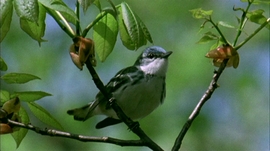 But it wouldn’t matter how good the information and presentation is (and it’s excellent), this DVD would not be worth getting without high quality video of the birds. Rest assured, the footage is spectacular. Watching this video, I was constantly catching myself smiling at the sight of these birds, just as if I was seeing them myself in the field. But it will give you a much closer and more intimate look at them than you will get from any but the most exceptional field experience. I can’t imagine how many hours it took, and how much film was shot, to get this amount of exceptional footage, but it was clearly worth it.
But it wouldn’t matter how good the information and presentation is (and it’s excellent), this DVD would not be worth getting without high quality video of the birds. Rest assured, the footage is spectacular. Watching this video, I was constantly catching myself smiling at the sight of these birds, just as if I was seeing them myself in the field. But it will give you a much closer and more intimate look at them than you will get from any but the most exceptional field experience. I can’t imagine how many hours it took, and how much film was shot, to get this amount of exceptional footage, but it was clearly worth it.
Watching Warblers WEST
As good as its predecessor is, Watching Warblers WEST is even better. It clocks in at 1:10:17, and covers 24 species found west of the Great Plains and in Texas. On average, it devotes a little longer time to each bird at 2:30 per species. The format and type of information presented is largely the same, except that the maps are now integrated into the main feature. The photography looked a little improved to me, showing these birds even better than the eastern ones. The maps, now based on NASA satellite images, also looked incredible.
Please note that these are not intended to be video field guides. While some identification information is given, and the video should be extremely useful in studying these birds, this is not the primary purpose of the films. Also, most of the warblers are only shown on their breeding ground (after all, they are much easier to film when singing on territory!). That means you won’t see some species, such as Magnolia and Chestnut-sided, in their drabber nonbreeding attire.
Video Quality
Not only is the video footage itself extraordinary, its presentation on these DVDs is also great. It is presented in anamorphic 16:9/widescreen format. Basically, that means that this is a high-resolution transfer that will fill the screen on a widescreen TV. This isn’t going to look as good as the latest Hollywood blockbuster, but it is still much, much better than I was expecting. Unsurprisingly, the newer western DVD looks better, being clearer and sharper. But all of these warblers are going to look fantastic on any display device, from a cell phone to a home theater.
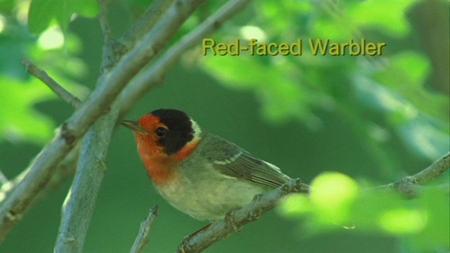
Sound Quality
The audio is presented in two-channel stereo. While I would have loved a full 5.1 surround mix of warbler songs, I have to admit that would be overkill. As it is, the sound is perfectly presentable.
You can choose to watch the film with or without the narration, which is a very nice option.
Extras
Watching Warblers comes with a decent selection of extras. Chorus of Songs (4:22) is simply a shortcut to the end of the main program where each warbler is shown singing for a couple of seconds each. Fun with Songs (6:13) again shows a select few warblers singing. But after playing the song in real time, it then replays it slowed down to 20% of normal. This reveals intricacies and beauty that our limited sense of hearing can’t notice in real time. Colima Quest (5:19) is a behind-the-scenes look at the effort to video the Colima Warbler in Big Bend National Park. Seeing this increased my respect for Male, Fieth, and their crew; this project was obviously not an easy undertaking. I just wish more behind-the-scenes footage would have been included. Finally, there are some previews of their other films.
This is the only category where the western DVD is not superior to its eastern counterpart. It has its own Chorus of Songs (3:20) and Fun with Songs (7:47).
Recommendation
I really can’t believe how good this video footage is, and the DVD transfer shows it off outstandingly. You could watch warblers for years and not get views as good as these. Combined with the fact-filled narration and extras, these DVDs are a must for warbler aficionados.
You can order these, and other similar DVDs, from Birdfilms.
Disclosure: I get a small commission for purchases made through links in this post.
Disclosure: The item reviewed here was a complementary review copy provided by the producers. But the opinion expressed here is my own, it has not been influenced in any way.

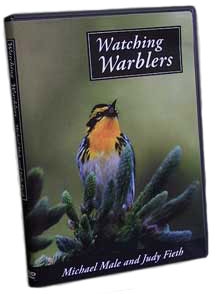
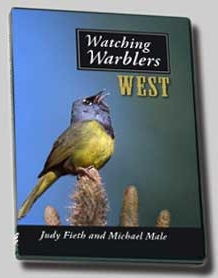
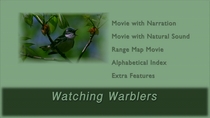

Have bought this DVD and it is quality, some of the best filming I have seen, good narration and good distribution maps.